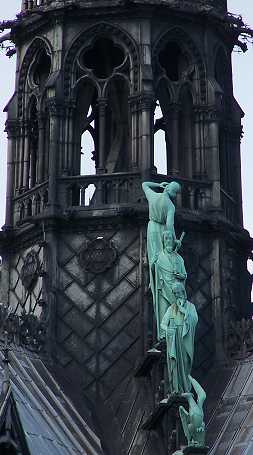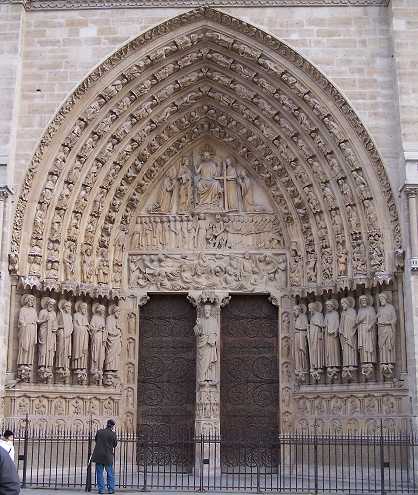Notre Dame - Paris PagesHotel de Lauzun, the Marais 4th arrondissement |
|
 |
Notre Dame historyThe site where Notre Dame stands has always been important in Parisian history, and in pre-Christian times it was on this site that the Druids sacrificed virgins to their gods. Building started in 1163 when the cornerstone was laid by Pope Alexander III, and was completed almost 200 years later. The master builder, who was also architect, contractor and foreman, has come down to us simply as "Richard, the mason". During the French Revolution many of the statues of the saints (see the photograph below) had their heads removed under the impression that they were statues of Kings. Many of these heads were later recovered and now rest in the Cluny Museum. All the original bells, except the largest, Emmanuel, have also been replaced. This view on the left shows the famous rose window. It is possible to climb the 387 steps up to the twin towers where you will get a gargoyle's view of Paris. |
 |
More recently, when an underground car park was being excavated the remains of an even earlier church, and part of the original port were found. This has now been opened up as the Crypt of Notre Dame, and above this, the outline of the original church has been traced in bronze in the square in front of Notre Dame. |
|
|
Also, outside Notre Dame is the stone slab where all the distances from and to Paris are measured from. Notre Dame then and nowThe thing to try to imagine about Notre Dame is the impression it must have had on the populace of the day. They lived in small, dark largely wood built houses, in narrow stinking streets which reached up almost to the walls of the cathedral; the current square is six times bigger than it was when the cathedral was built. So from the dark, and dreary closed-in filthy streets they would step out and be confronted by this huge, ornate edifice where all the sculptures were either gilded or painted, and the stones seemed to reach to the sky. Added to this was the excitement and entertainment of the fairs, plays and stalls crowding the square.
|
On the left is a view of the front of the cathedral. There are three main doors (see above) , the central one (see left) depicts the Last Judgment, the one to the left of this tells the story of the Virgin, and the one on the right the story of St. Anna. To the right of this picture are some public toilets, not a thing I'd take a photograph of, but these are very clean and well kept ones. You have to pay to get in, but it is worth it as clean public toilets are not all that easy to find in Paris. |
 |
Also on the right is the statue of Charlemagne on his horse. And, round the side of Notre Dame, up a little side street called rue Chanoinesse is a very good restaurant in a house built in 1512, the restaurant is called Au Vieux Paris, and all their food is organic. In fact rue Chanoinesse and the few streets around it are all that were left untouched by Haussmann on Ile de la Cite when he was modernising. And they give an idea of what the surroundings of Notre Dame would have been like from medieval to 18th century times. Picnic at Notre DameAt the back of Notre Dame there are some gardens which are perfect for sitting down to have a rest or a picnic lunch, but across the road there are more gardens which have a very sad tale to tell. If you go in and walk to the end point of the island you can go down some steps. It is from here that the Jews and other "undesirables" were transported off to the concentration camps during the German occupation. Few returned. Not a very proud page of Parisian history, but not one that we should forget, lest we ever make the same mistakes again. As with so many other famous buildings in Paris. During the revolution Notre Dame was firstly put up for sale, then used as a storehouse, and then listed for demolition. Luckily Napoleon decided to have his coronation here, so that saved it for a few more years. However it had been looted of anything valuable during the revolution so to hide the bareness Napoleon had to have the walls draped with hangings. This can be seen in David's famous painting of the coronation in the Louvre. Notre Dame saved by the Hunchback After this the cathedral was again neglected, and it wasn't until the great success of Victor Hugo's The hunchback of Notre Dame that a committee was formed for its renovation. Then again in 1871 during the Commune the cathedral was almost lost forever. All the benches and wooden barriers had been piled up in the centre and sprayed with petrol and set alight. It was only the prompt action of the doctors in the nearby Hotel Dieu hospital that saved it. |
 |
And, of course Adolf Hitler had marked it out for destruction, and explosive charges had been in place for some time, but the order to burn Paris was never given by the general in charge. Left, a view of the back taken from Pont de la Tournelle. Below left and right close up of the figures climbing up the spire. |
 |
 |
copyright2003-2012 |





